The Aquarium Decor Market is estimated to be valued at USD 2.9 billion in 2025 and is projected to reach USD 4.7 billion by 2035, registering a compound annual growth rate (CAGR) of 4.8% over the forecast period.
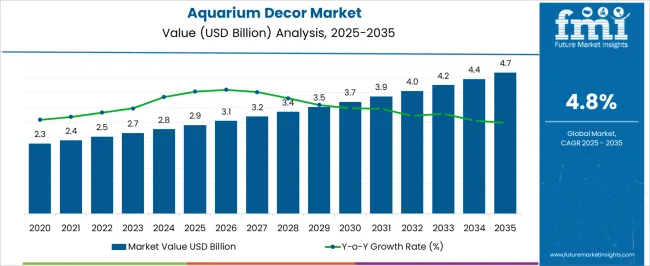
| Metric | Value |
|---|---|
| Aquarium Decor Market Estimated Value in (2025 E) | USD 2.9 billion |
| Aquarium Decor Market Forecast Value in (2035 F) | USD 4.7 billion |
| Forecast CAGR (2025 to 2035) | 4.8% |
The aquarium decor market is expanding consistently, fueled by rising consumer interest in ornamental fishkeeping, home aesthetics, and wellness-driven hobbies. Industry publications and product launch announcements have emphasized that aquariums are increasingly viewed as lifestyle enhancements, combining relaxation benefits with interior design appeal.
Growth in disposable income, particularly in urban households, has encouraged spending on premium and customizable decor items. Manufacturers have diversified product portfolios with artificial plants, themed decorations, and functional designs that enhance both visual appeal and aquatic habitat balance.
Furthermore, the rising popularity of aquascaping competitions and social media trends has elevated consumer demand for innovative decor solutions. The market outlook remains positive as advancements in safe, durable materials and environmentally friendly manufacturing practices gain prominence. Future growth will be underpinned by affordability in mid-range products, the rising adoption of artificial plants as low-maintenance options, and continued reliance on plastic as the dominant material choice due to its versatility and cost-effectiveness.
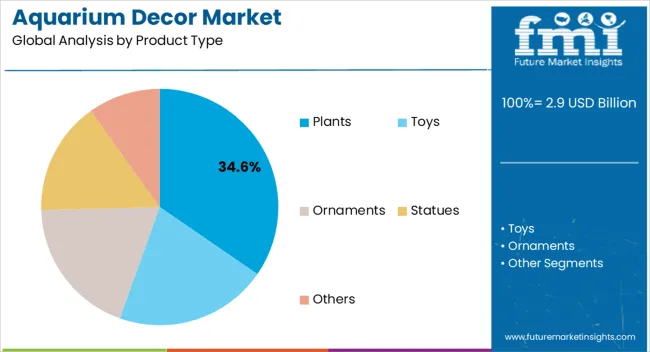
The Plants segment is projected to account for 34.6% of the aquarium decor market revenue in 2025, maintaining its leadership position among product types. Growth in this segment has been shaped by increasing consumer preference for natural-looking environments that replicate aquatic ecosystems.
Artificial plants have gained traction due to their low maintenance, absence of algae-related issues, and suitability for both novice and experienced aquarium owners. Retail studies have highlighted consistent demand for plant-based decor due to its ability to enhance the aesthetic appeal of aquariums while providing hiding spaces for fish.
Additionally, product innovations such as flexible stems, UV-resistant coatings, and varied color palettes have strengthened consumer interest. As awareness of sustainable alternatives rises, manufacturers have also introduced eco-friendly plant replicas, further boosting adoption. These attributes are expected to sustain the segment’s growth momentum.
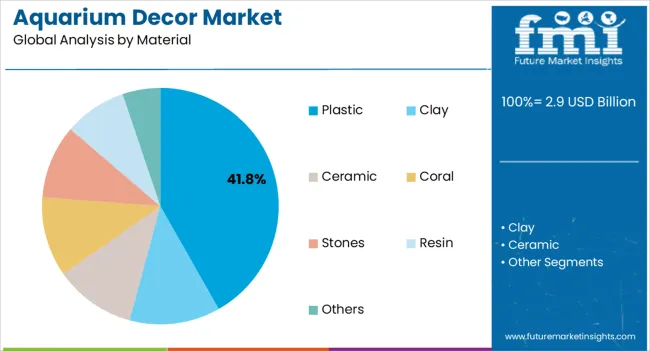
The Plastic segment is projected to hold 41.8% of the aquarium decor market revenue in 2025, positioning it as the leading material category. This dominance has been supported by plastic’s versatility in design, cost-effectiveness, and durability under aquatic conditions.
Industry updates have emphasized that plastic-based decorations are preferred for their lightweight properties, ease of molding into diverse shapes, and resistance to water damage. Manufacturers have leveraged plastic to produce a wide range of affordable decor items, from plants to themed ornaments, making it accessible to a broad consumer base.
Furthermore, advances in non-toxic, fish-safe plastics have strengthened consumer confidence in their long-term use. Plastic decor’s availability across online and offline retail channels has also contributed to its widespread adoption. With increasing product innovations and the continued affordability advantage, the Plastic segment is expected to retain its leadership.
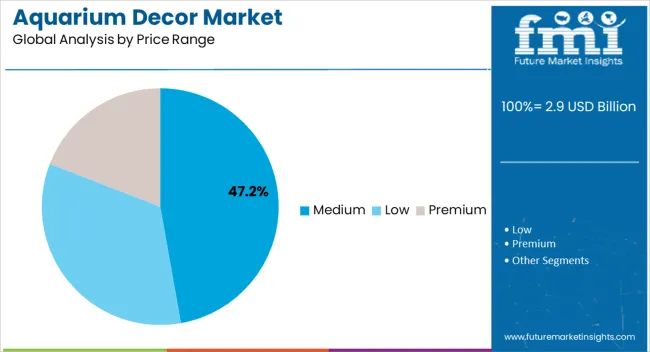
The Medium price range segment is projected to capture 47.2% of the aquarium decor market revenue in 2025, reflecting its balance between affordability and product quality. Consumers in this segment have demonstrated consistent demand for decor items that combine aesthetic appeal with durability without incurring high costs.
Retail data has shown that medium-priced products dominate both offline and e-commerce platforms, catering to households seeking value-for-money aquarium solutions. Brands have prioritized this range to target middle-income consumers, offering diverse designs and customizable features.
Seasonal sales and bundled product offerings have further boosted purchasing activity within this category. Additionally, medium-priced decor items have attracted repeat purchases due to their accessibility and ability to cater to both entry-level and experienced aquarium enthusiasts. As consumer spending patterns continue to favor value-driven options, the Medium price range is expected to remain the largest contributor to market revenues.
The key trend driving the aquarium decor market is the rise in pet adoption rate, including fish. Due to the growing fascination with the undersea world and its impact on the environment in houses and other residential and business spaces, the worldwide aquarium decor market has grown in popularity over the years.
Aquariums have become a vital interaction with nature for the younger generation and a source of information about aquatic animals. In recent years, keeping fish has been a popular pastime among people all over the world, causing the worldwide aquarium decor industry to develop at a rapid pace.
Nowadays, due to the rise of awareness among consumers about environmental sustainability, they prefer more environmentally friendly products. Consumers demand natural and live plants, toys made from stones, ornaments made from natural material, etc., as they are more durable and biodegradable. Not only has this changed the aquarium décor market outlook, but also impacted the other industries heavily.
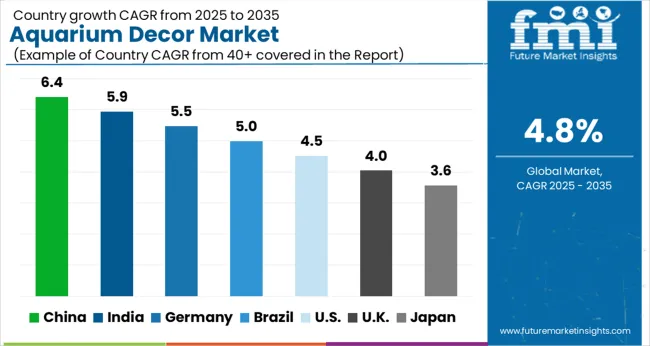
China is always leading in plastic toys manufacturing
China has always led the plastic toy market globally. In recent years China has been investing more money in research and development. They are developing high-technology plastic toys as aquarium toys. Aquarium décor manufactured in China is found to be durable and sustainable for the environment.
Pet adoption is on a rise in the United Kingdom
The United Kingdom is one of the key markets catering to the growing demand for aquarium decor. During the forecast period 2025 to 2035, the United Kingdom aquarium décor market is likely to develop rapidly. In the United Kingdom, many people already have fish and aquariums. This leads to them buying aquarium accessories to make their fishes feel at home and in their natural habitat.
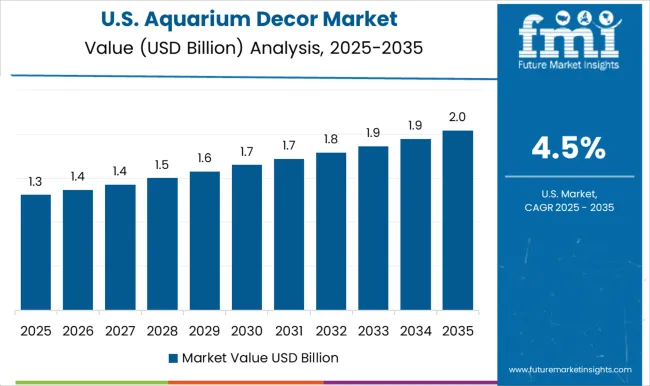
Giving back to the nature is driving the market in the United States
Various benefits supplied by fish attract diverse clients, such as adopting various fish species, connecting with nature, and talking to fish may help you relax. As per recent research, aquarium accessories can assist enhance the rate of survival of fishes in regions where they are present. Thus, in the next years, consumption in the global market sector is expected to increase as consumers become more aware.
Live plants are environment friendly aquarium décor
Various products can be used as aquarium accessories, for example, Plants, Toys, Ornaments, Statues, and Others. The most popular product used as aquarium décor has been planted in recent years. Plants are durable and very environmentally friendly. They help filtrate the aquarium, oxygenate the tank, help in breeding among fishes and provide natural food for the fishes in the aquarium.
Low price range products are preferred by consumers
Aquarium décor comes in three different price ranges: low, medium, and premium. Consumers nowadays prefer the low-price range of aquarium accessories. Low-price range aquarium accessories include natural plants and plastic toys. Natural plant is available at low prices because of easy availability, and one does not need to take exceptional care of them.
E-commerce websites made the most sales in the aquarium décor market
Aquarium décors are sold at different stores like E-commerce Websites. Company Owned Websites, Hypermarkets and Supermarkets, Specialty Stores, and Other Retail Stores. E-commerce websites contributed majorly to the aquarium décor market in recent years. This was due to the travel bans, break in the supply chain during the covid-19 pandemic, and lockdown. E-commerce websites advertised and made sales of aquarium decor using social media platforms like YouTube, Instagram, etc.
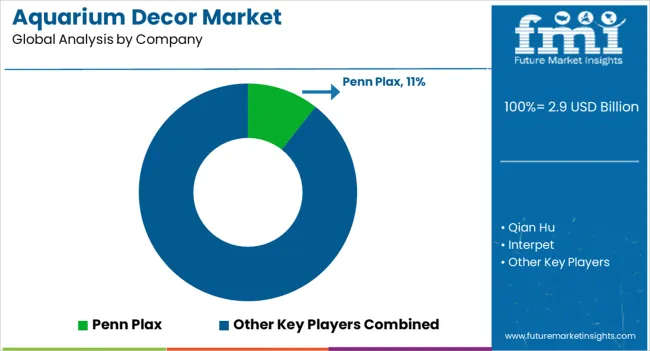
Leading industry players are revolutionizing their product lines by developing attractive aquarium accessories for adopters while offering optimal comfort and function for the fishes.
For instance:
Recent developments
Saving Money and Reducing Carbon Emissions
Several variables affect how much power an aquarium needs, but the biggest ones are the tank's volume and features. A tiny 10-gallon tank would only use around 150kWh per year, which, at an average of 12 cents per kWh, would amount to less than D20 annually. However, the price may grow dramatically if you go for a larger tank and include energy-intensive features like powerful lights and a sump system.
Aquarium lighting accounts for about 45% of total tank utilization, making it the greatest energy consumer among tank equipment. You will need a tank heater to keep the water at tropical temperatures, and a tank filter is essential for any aquarium.
Heating and filtration for most tanks are required around the clock, while illumination can be controlled as needed. However, it is important to remember that different tanks call for various illumination intensity levels. For instance, a planted aquarium may need powerful lighting, whereas a fish-only tank with a single fluorescent bulb for daytime illumination may suffice.
LED lighting has been the most important improvement in aquarium lighting. Compared to the 15-40 watts of a typical fluorescent bulb, the 75-160 watts of power used by VHO bulbs are quite noticeable. The power consumption of metal halides could reach 1,000 watts; adding in the cost of running an auxiliary fan or chiller is an additional consideration.
On the other hand, LED lights use significantly less energy and produce no heat. Additionally, they are available in a range of hues that make it possible to create both daytime and nighttime lighting systems.
Easily Transportable
It is well-known in the aquarium community that a larger tank size makes it easier to keep the tank's conditions consistent. Therefore, it makes sense that a tank with a volume of 10 gallons will be far more affected by a minor change in pH or chemistry than a tank with 100 gallons.
However, the gap is diminishing as modern technology makes tiny equipment and aquarium systems more accessible and user-friendly.
Currently, micro tanks are all the rage in aquarium accessories. When caring for a nano aquarium, even the smallest misstep might have catastrophic effects on the aquatic life inside.
The hood of many nano tanks already has necessary components like lighting and filtration, but you may also require some optional extras. However, compact aquarium equipment is a huge improvement for tanks where you do not want your equipment to detract from the aesthetics in any way, not just nano tanks.
Robotics and Smart Appliances
Once upon a time, the extent of flexibility to automate aquarium processes was limited to setting a timer for tank lights. The use of automatic timers allowed for the control of the on/off schedule of tank illumination and the integration of automatic feeds.
Today, aquariums are at the stage where they may be self-sufficient because of an automated technology.
Thanks to several innovative technologies and aquarium controllers, it is now possible to automate or operate various pieces of aquarium equipment with a single device. For instance, consider the following aquarium controllers.
Temperature Controller/Thermostat
This type of thermostat or temperature controller has a probe that may be placed within the tank. A thermometer and thermostat are connected to the probe. The device turns on or off automatically based on whether the tank's temperature is higher than or lower than the set point.
Automatic Water Addition
Evaporation is a widespread problem in reef aquariums and other tank layouts. Evaporation not only reduces the amount of water in your tank, but it can also disrupt the water's chemistry. Automatic top off (ATO) systems monitor tank levels and either add or remove water as needed.
PH Controller
A pH controller is useful for both freshwater and saltwater aquariums since it helps keep the pH level constant. The pH of your tank can be adjusted to your liking, and a carbon dioxide system can be added to maintain that range. The carbon dioxide system is activated to decrease pH when the probe detects a rise in pH outside the chosen range.
Oxygen Monitor
Dissolved oxygen levels in an aquarium can be tracked with an in-tank probe and portable programmable gadget, known as an oxygen monitor. Having a system that monitors the oxygen/carbon dioxide balance in an aquarium makes it much easier to keep the environment stable.
Aquarium Monitor
Water temperature, pH, and ammonia levels are only some of the water chemistries that may be monitored by aquarium monitors, which are now available alongside more specialized systems like pH controllers. Even though many of these gadgets log data on a PC, some newer models allow you to retrieve this data remotely.
Rapid Repair with a Single Touch
In today's aquariums, some of the most innovative systems are fully autonomous. You can keep an eye on your aquarium from afar and spot any changes or emerging problems with the help of smartphone apps and computer programmes that link with your aquarium equipment. A future possibility is to have all your tank equipment connected to each other and managed from a single device, such as a smartphone or tablet. With the push of a button, you can monitor your tank's vital signs, tweak the settings of your equipment, and even have your tank dosed with chemicals or medications automatically if necessary.
Aquaculture Techniques
Technically speaking, aquaponics is distinct from maintaining an aquarium in that it entails raising fish and using the water and the fish waste to nourish plants. The nitrogen-rich tank water created by the fish's digestion and excrement can then be poured into the plant and vegetable beds.
Plants thrive in the nutrient-rich water, and depending on the fish you maintain, you may be able to use some of the plants as food. A self-sustaining system, it still needs regular inspection and upkeep, but modern tools make that job much simpler.
| Attribute | Details |
|---|---|
| Forecast Period | 2025 to 2035 |
| Historical Data Available for | 2020 to 2025 |
| Market Analysis | USD million for Value |
| Key Regions Covered | North America; Latin America; Europe; South Asia; East Asia; Oceania; MEA |
| Key Countries Covered | USA, Canada, Mexico, Brazil, Peru, Chile, Germany, UK, France, Spain, Italy, Russia, India, Thailand, Indonesia, Malaysia, China, Japan, South Korea, Australia, New Zealand, GCC, Southern Africa, and North Africa |
| Key Segments Covered | Product type, Form, End-user Application, Distribution channel. |
| Key Companies Profiled | Penn Plax; Qian Hu; Interpet; Jebao; Tropical Marine Centre Spectrum Brands Guangdong Boyu Group; API; Aquaria; AZOO; United Pet Group; ZooMed; Hagen; Blue Ribbon; Hailea Arcadia; Live Aquaria; Aqueon; Guangdong Boyu Group; Spectrum Brands |
| Report Coverage | Market Forecast, Company Share Analysis, Competition Intelligence, DROT Analysis, Market Dynamics and Challenges, and Strategic Growth Initiatives |
| Customization & Pricing | Available upon Request |
The global aquarium decor market is estimated to be valued at USD 2.9 billion in 2025.
The market size for the aquarium decor market is projected to reach USD 4.7 billion by 2035.
The aquarium decor market is expected to grow at a 4.8% CAGR between 2025 and 2035.
The key product types in aquarium decor market are plants, toys, ornaments, statues and others.
In terms of material, plastic segment to command 41.8% share in the aquarium decor market in 2025.






Our Research Products

The "Full Research Suite" delivers actionable market intel, deep dives on markets or technologies, so clients act faster, cut risk, and unlock growth.

The Leaderboard benchmarks and ranks top vendors, classifying them as Established Leaders, Leading Challengers, or Disruptors & Challengers.

Locates where complements amplify value and substitutes erode it, forecasting net impact by horizon

We deliver granular, decision-grade intel: market sizing, 5-year forecasts, pricing, adoption, usage, revenue, and operational KPIs—plus competitor tracking, regulation, and value chains—across 60 countries broadly.

Spot the shifts before they hit your P&L. We track inflection points, adoption curves, pricing moves, and ecosystem plays to show where demand is heading, why it is changing, and what to do next across high-growth markets and disruptive tech

Real-time reads of user behavior. We track shifting priorities, perceptions of today’s and next-gen services, and provider experience, then pace how fast tech moves from trial to adoption, blending buyer, consumer, and channel inputs with social signals (#WhySwitch, #UX).

Partner with our analyst team to build a custom report designed around your business priorities. From analysing market trends to assessing competitors or crafting bespoke datasets, we tailor insights to your needs.
Supplier Intelligence
Discovery & Profiling
Capacity & Footprint
Performance & Risk
Compliance & Governance
Commercial Readiness
Who Supplies Whom
Scorecards & Shortlists
Playbooks & Docs
Category Intelligence
Definition & Scope
Demand & Use Cases
Cost Drivers
Market Structure
Supply Chain Map
Trade & Policy
Operating Norms
Deliverables
Buyer Intelligence
Account Basics
Spend & Scope
Procurement Model
Vendor Requirements
Terms & Policies
Entry Strategy
Pain Points & Triggers
Outputs
Pricing Analysis
Benchmarks
Trends
Should-Cost
Indexation
Landed Cost
Commercial Terms
Deliverables
Brand Analysis
Positioning & Value Prop
Share & Presence
Customer Evidence
Go-to-Market
Digital & Reputation
Compliance & Trust
KPIs & Gaps
Outputs
Full Research Suite comprises of:
Market outlook & trends analysis
Interviews & case studies
Strategic recommendations
Vendor profiles & capabilities analysis
5-year forecasts
8 regions and 60+ country-level data splits
Market segment data splits
12 months of continuous data updates
DELIVERED AS:
PDF EXCEL ONLINE
Decor Paper Market Size and Share Forecast Outlook 2025 to 2035
Decor Paper Industry Analysis in India Size and Share Forecast Outlook 2025 to 2035
Decorative Rugs Market Size and Share Forecast Outlook 2025 to 2035
Decorations and Inclusions Market Size and Share Forecast Outlook 2025 to 2035
Decorative Coatings Market Size and Share Forecast Outlook 2025 to 2035
Aquarium Hydrometers Market Size and Share Forecast Outlook 2025 to 2035
Decorated Apparel Market segmented by Product, End-user and Distribution Channel through 2025 to 2035
Decorative Car Accessories Market Growth - Trends & Forecast 2025 to 2035
Aquarium & Fish Bowls Market Growth - Trends & Forecast to 2035
Aquarium Water Treatment Market Growth - Trends & Forecast 2025 to 2035
Aquarium Heaters and Chillers Market - Growth & Forecast 2025 to 2035
Aquarium Protein Skimmers Market Growth - Trends & Demand Forecast 2025 to 2035
Decorative Inks Market Analysis by Application and Region Through 2035
Decorative Paints Market Growth – Trends & Forecast 2025 to 2035
Market Share Breakdown of Decor Paper Manufacturers
Aquarium Pumps & Filters Market Demand 2024 to 2034
Decorticator Machine Market Growth – Trends & Forecast 2024-2034
Decorative Surface Films Market
Decorative Laminates Market Growth 2022 to 2032
MDF Decorative Overlays Market Size and Share Forecast Outlook 2025 to 2035

Thank you!
You will receive an email from our Business Development Manager. Please be sure to check your SPAM/JUNK folder too.
Chat With
MaRIA